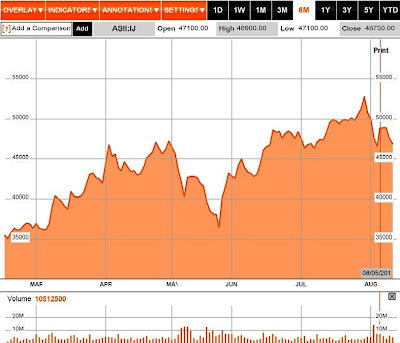
Are U Interesting With This?
I think at this level ISAT is very attractive for medium term investment. We maintain Buy ISAT on expected further earnings upgrades due to management turnaround story, positive consolidated operating free cash flow to equity. I put target price for ISAT at IDR 5586 (14.3x PE’11 consensus).
Fundamental Note
• ISAT will continue to focus on its data division, where there is growth potential.
• Average toll usage (ARPU) subscribers of Indosat rose 7.7 percent, so it boosted its net profit to Rp285, 9 billion in the first quarter of this year. Achievements in the first quarter of this year are part of the strategy of focusing on the value (revenue).
• In the first quarter of 2010, Indosat's net profit surged 139.2 percent to Rp285, 9 billion over the same period last year amounted to Rp119, 5 billion.
• The number of subscribers had increased by 18 percent to 39.1 million subscribers last year from a total of 33.3 million and 3.5G subscribers increased by 118, five per cent to 756 thousand from last year amounted to 346 000 subscribers.
• Currently, Indosat has been holding the device Sony Ericsson to modernize the network Receiver base transmission station (BTS). Indosat estimate the impact of modernization, these networks will begin to be felt in the September 2010.
• Indosat would continue to implement its strategy of acquiring value customers and would focus to improve its ARPU mix by retaining a larger share of medium to high end customers.
• Data would be key growth driver; MIDI revenues were up q/q.
• Indosat expects to achieve growth in the wireless segments of ex. Java regions while growth in Java would be primarily broadband driven.
• The new management team is also actively crunching operating costs and capex.
• Rising EBITDA should facilitate Indosat’s first ever positive cellular operating free cash flow (OPFCF) result in FY10, positive consolidated OPFCF and positive consolidated free cash flow to equity.
• Now ISAT trade at 14.15x PE’10 and 11.84x PE’11 (EPS Consensus).

Technical Note
• ISAT closed at support since 21 December 2009 at 4500. Stochastic indicated that the share on oversold position. With retracement methodology ISAT possibility pull back at 5150 level.
Bang Juntri
DISCLAIMER: This report is issued by Bang Juntri. Although the contents of this document may represent the personal opinion of Bang Juntri. We cannot guarantee its accuracy and completeness.







